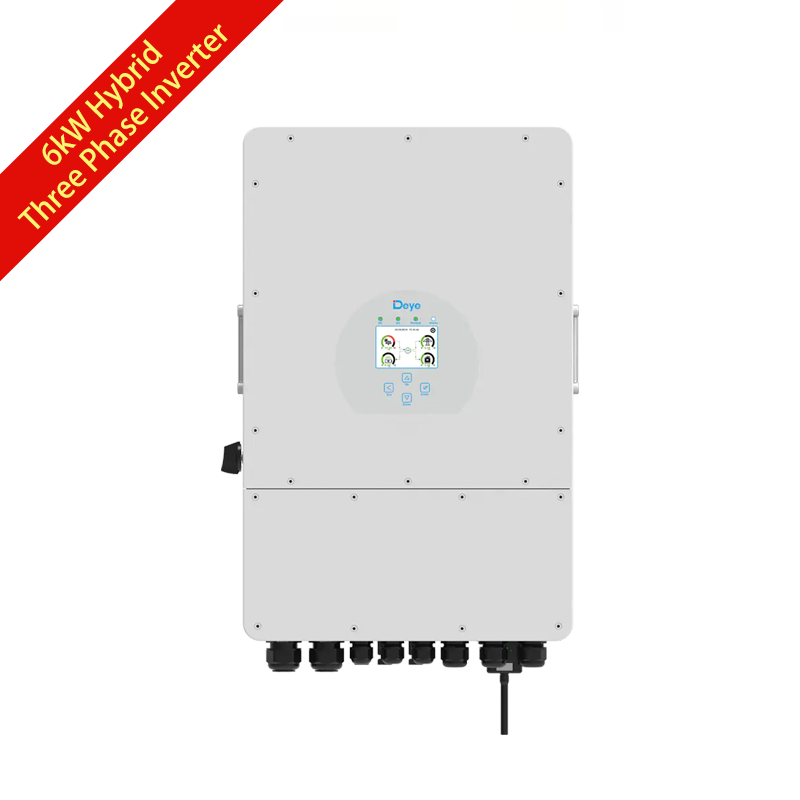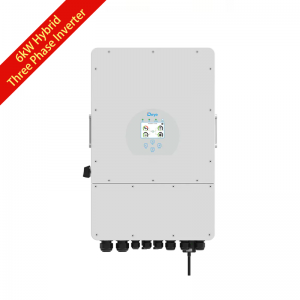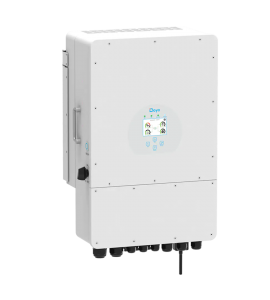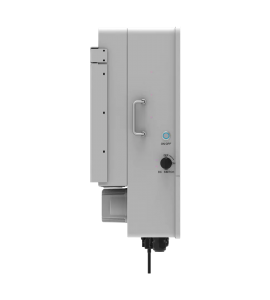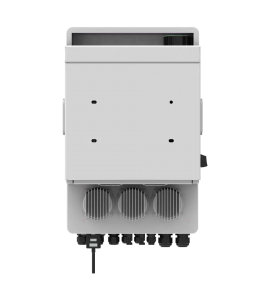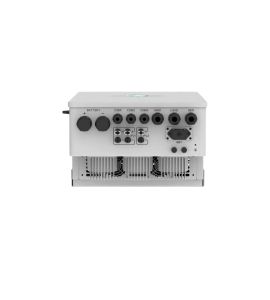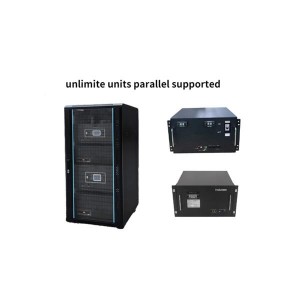

Deye 6kW Three Phase Hybrid Solar Inverter
ABOUT
Deye 6kW Three Phase Hybrid Solar Inverter
| Model | SUN-6K-SG04LP3-EU |
| Battery Input Data | |
| Battery Type | Lead-acid or Lithium-ion |
| Battery Voltage Range (V) | 40~60V |
| Max. Charging Current (A) | 150A |
| Max. Discharging Current (A) | 150A |
| Charging Curve | 3 Stages / Equalization |
| External Temperature Sensor | Yes |
| Charging Strategy for Li-Ion Battery | Self-adaption to BMS |
| PV String Input Data | |
| Max. DC Input Power (W) | 7800W |
| Rated PV Input Voltage (V) | 550V(160V~800V) |
| Start-up Voltage (V) | 160V |
| MPPT Range (V) | 200V-650V |
| Full Load DC Voltage Range (V) | 350V-650V |
| PV Input Current (A) | 13A+13A |
| Max. PV ISC (A) | 17A+17A |
| Number of MPPT / Strings per MPPT | 2/1 |
| AC Output Data | |
| Rated AC Output and UPS Power (W) | 6000W |
| Max. AC Output Power (W) | 6600W |
| Peak Power (off grid) | 2 times of rated power, 10 S |
| AC Output Rated Current (A) | 9.1/8.7 |
| Max. AC Current (A) | 13.6/13 |
| Max. Continuous AC Passthrough (A) | 45A |
| Output Frequency and Voltage | 50/60Hz;3L/N/PE 220/380Vac,230/400Vac |
| Grid Type | Three Phase |
| Current Harmonic Distortion | THD<3% (Linear load<1.5%) |
| Efficiency | |
| Max. Efficiency | 97.60% |
| Euro Efficiency | 97.00% |
| MPPT Efficiency | 99.90% |
| Protection | |
| PV Input Lightning Protection | Integrated |
| Anti-islanding Protection | Integrated |
| PV String Input Reverse Polarity Protection | Integrated |
| Insulation Resistor Detection | Integrated |
| Residual Current Monitoring Unit | Integrated |
| Output Over Current Protection | Integrated |
| Output Shorted Protection | Integrated |
| Output Over Voltage Protection | Integrated |
| Surge protection | DC Type II / AC Type Ⅲ |
| Certifications and Standards | |
| Grid Regulation | CEI 0-21, VDE-AR-N 4105, NRS 097, IEC 62116, IEC 61727, G99, G98, VDE 0126-1-1, RD 1699, C10-11 |
| Safety EMC / Standard | IEC/EN 61000-6-1/2/3/4, IEC/EN 62109-1, IEC/EN 62109-2 |
| General Data | |
| Operating Temperature Range (℃) | -45~60℃, >45℃ Derating |
| Cooling | Smart cooling |
| Noise (dB) | <45 dB |
| Communication with BMS | RS485; CAN |
| Weight (kg) | 33.6 |
| Size (mm) | 422W×699.3H×279D |
| Protection Degree | IP65 |
| Installation Style | Wall-mounted |
| Warranty | 5 years |
How does inverter convert DC to AC?
In recent years, with the vigorous development of the photovoltaic industry, pv power systems have received more and more attention. As we all know, the pv power system is composed of components, solar inverters, brackets, cables and other parts. The inverter is the most intuitive component, it can convert sunlight energy into direct current; the bracket plays the role of placing, installing and fixing the component; the cable is essential in the power transmission system. Among them, the hybrid solar inverter, which can convert the direct current generated by photovoltaic modules into alternating current, is the "heart" of the photovoltaic system and controls the production efficiency of photovoltaic power plants.
Direct current (DC): The direction of the direct current and voltage is the same, and the direction of the current is always the same. The dry batteries and lead-acid batteries we commonly use in life use direct current.
Alternating current (AC): The current direction and magnitude of alternating current will change periodically over time. The household 220V power supply used in daily life is AC.
From the difference between DC and AC, we can find that DC has great limitations in daily applications. For example, AC loads of household appliances cannot be powered by DC power, and long-distance transportation will lose most of the power. Therefore, in order for photovoltaic power generation to be widely used in our daily life, a hybrid solar inverter that can convert the direct current generate into alternating current is indispensable.
While the PV array transmits DC power to the solar inverter, the DC power is quickly transferred back and forth through the inverter's internals. In this process, the hybrid solar inverter forces the direct current to constantly change direction, creating a square-wave alternating current. However, the square wave AC waveform is not smooth, and the voltage has been changing suddenly, which will seriously affect the life of electrical appliances.
Therefore, the inverter speeds up the transmission speed, and through the sinusoidal pulse width modulation method (SPWM), the multiple pulses in each sinusoidal period are naturally or regularly modulated in width, so that these pulses are sequentially modulated to be equivalent to sinusoidal pulse train of waves,form a sinusoidal current output, thereby making the square wave alternating current into a sinusoidal alternating current, and achieving the purpose of converting direct current into alternating current.
